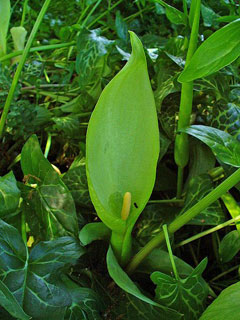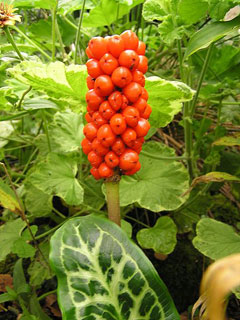 |
|
http://commons.wikimedia.org/wiki/File:Arum_italicum_002.JPG |
 |
|
Translate this page:
Summary
Bloom Color: Orange.
Main Bloom Time: Late spring, Mid spring. Form: Upright or erect.
Physical Characteristics

 Arum_italicum is a PERENNIAL growing to 0.4 m (1ft 4in) by 0.3 m (1ft).
Arum_italicum is a PERENNIAL growing to 0.4 m (1ft 4in) by 0.3 m (1ft).
See above for USDA hardiness. It is hardy to UK zone 6 and is not frost tender. It is in flower from April to May. The species is monoecious (individual flowers are either male or female, but both sexes can be found on the same plant) and is pollinated by Flies.
Suitable for: light (sandy), medium (loamy) and heavy (clay) soils. Suitable pH: mildly acid, neutral and basic (mildly alkaline) soils. It can grow in full shade (deep woodland) semi-shade (light woodland) or no shade. It prefers dry or moist soil.
UK Hardiness Map
US Hardiness Map
Synonyms
A. neglectum. A. modicense. A. numidicum.
Plant Habitats
Edible Uses
Tuber - cooked and used as a vegetable[2, 177]. An arrowroot can be extracted from the dried root[105]. The root must be thoroughly dried or cooked before being eaten, see the notes above on toxicity.
References More on Edible Uses
Medicinal Uses
Plants For A Future can not take any responsibility for any adverse effects from the use of plants. Always seek advice from a professional before using a plant medicinally.
None known
References More on Medicinal Uses
The Bookshop: Edible Plant Books
Our Latest books on Perennial Plants For Food Forests and Permaculture Gardens in paperback or digital formats.

Edible Tropical Plants
Food Forest Plants for Hotter Conditions: 250+ Plants For Tropical Food Forests & Permaculture Gardens.
More

Edible Temperate Plants
Plants for Your Food Forest: 500 Plants for Temperate Food Forests & Permaculture Gardens.
More

More Books
PFAF have eight books available in paperback and digital formats. Browse the shop for more information.
Shop Now
Other Uses
References More on Other Uses
Cultivation details
Landscape Uses:Border, Container, Rock garden, Woodland garden. Prefers a humus rich soil and abundant water in the growing season[1]. Succeeds in sun or dry shade[90], preferring a shady position[4, 17, 31] and growing well in woodland conditions[1]. A polymorphic species[200], the British form has been separated off by some botanists as A. neglectum[17]. The leaves appear in the autumn, the plant staying green all winter[1, K]. The inflorescence has the remarkable ability to heat itself above the ambient air temperature to such a degree that it is quite noticeable to the touch[4]. This probably protects the flowers from damage by frost, or allows it to penetrate frozen ground. Members of this genus are rarely if ever troubled by browsing deer[233]. Special Features:Attractive foliage, Naturalizing, All or parts of this plant are poisonous.
References Carbon Farming Information and Carbon Sequestration Information
Temperature Converter
Type a value in the Celsius field to convert the value to Fahrenheit:
Fahrenheit:
The PFAF Bookshop
Plants For A Future have a number of books available in paperback and digital form. Book titles include Edible Plants, Edible Perennials, Edible Trees,Edible Shrubs, Woodland Gardening, and Temperate Food Forest Plants. Our new book is Food Forest Plants For Hotter Conditions (Tropical and Sub-Tropical).
Shop Now
Plant Propagation
Seed - best sown in a greenhouse or cold frame as soon as it is ripe[134]. The seed usually germinates in 1 - 6 months at 15°c[134]. Stored seed should be sown in the spring in a greenhouse and can be slow to germinate, sometimes taking a year or more. A period of cold stratification might help to speed up the process. Sow the seed thinly, and allow the seedlings to grow on without disturbance for their first year, giving occasional liquid feeds to ensure that they do not become mineral deficient. When the plants are dormant in the autumn, divide up the small corms, planting 2 - 3 in each pot, and grow them on in light shade in the greenhouse for a further year, planting out when dormant in the autumn. Division of the corms in summer after flowering[200]. Larger corms can be planted out direct into their permanent positions, though it is best to pot up the smaller corms and grow them on for a year in a cold frame before planting them out.
Other Names
If available other names are mentioned here
Native Range
TEMPERATE ASIA: Turkey (n.e. & n.w.), Russian Federation-Ciscaucasia (Ciscaucasia), Armenia, Georgia EUROPE: United Kingdom (south), Switzerland, Russian Federation-European part (European part (southwest)), Ukraine (incl. Krym), Former Yugoslavia, Albania, Bulgaria, Greece (incl. Crete), Italy (incl. Sardinia, Sicily), Spain (incl. Baleares), France (incl. Corsica), Portugal AFRICA: Spain (Canarias), Portugal (Madeira Islands), Algeria (north), Morocco (north), Tunisia (north)
Weed Potential
Right plant wrong place. We are currently updating this section.
Please note that a plant may be invasive in one area but may not in your area so it’s worth checking.
Conservation Status
IUCN Red List of Threatened Plants Status :

Growth: S = slow M = medium F = fast. Soil: L = light (sandy) M = medium H = heavy (clay). pH: A = acid N = neutral B = basic (alkaline). Shade: F = full shade S = semi-shade N = no shade. Moisture: D = dry M = Moist We = wet Wa = water.
Expert comment
Author
Mill.
Botanical References
17200
Links / References
For a list of references used on this page please go here
Readers comment